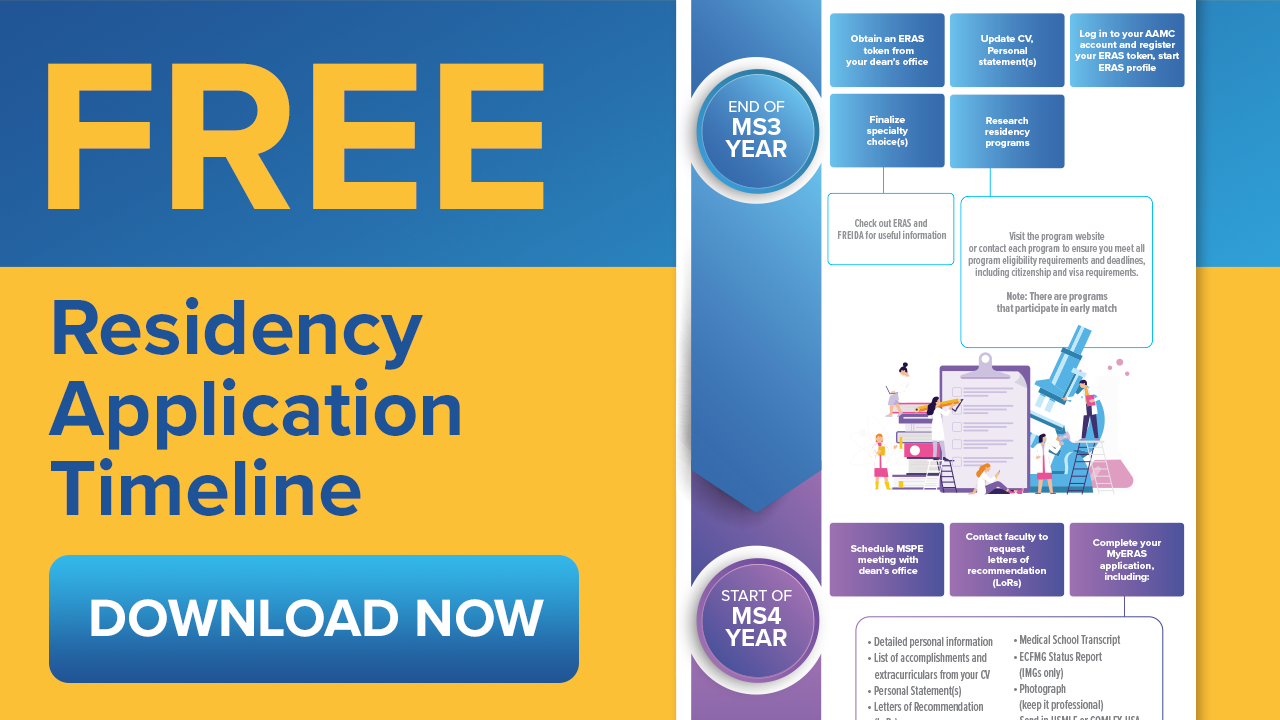Can you believe it? It’s already that time of the year. ERAS residency applications are just around the corner! That means it’s important to get familiar with the residency application timeline, so you don’t fall behind. We’re going to share key aspects of the residency application process with you, so you can stay on top of it all and land the residency you deserve after all the hard work you’ve put in.
First things first: You have from now until September 4th to create an ERAS residency application that’s optimized to highlight the top criteria that residency programs are looking for. At this point in time, there are already several aspects of your application you cannot change, including your Step scores, course/clerkship grades, evaluations, and dropped or failed courses.
Regardless of how well you did, the time that you put into crafting your application over the next few months, your preparations for audition rotations, sub-Is, and interviews will all be crucial. Take each step of the application process seriously, and always have a strategic plan of action.
As far as the residency application timeline is concerned, we’ll give you some tips for getting started, staying on top of it all, a heads-up on mistakes to avoid, and some pointers on how to finalize your application. It’s important information that can help you land the residency of your dreams.
Let’s begin with 6 important steps in the residency application process.
Starting your residency application can feel daunting, with a multitude of aspects to consider and the pressure to do well. If you’re applying to residency soon and aren’t sure where to start, download the FREE Residency Application Timeline to stay on track and make sure your top programs receive your very best residency application!
The Residency Application Timeline: 6 Steps to Keep in Mind
1. Choose your specialty.
First and foremost, decide on a specialty. If you haven’t decided on one yet, now is the time to do so. There are several reasons why. First, being indecisive about your specialty will slow down the application process. Second, applying for multiple specialties because you haven’t decided on one yet will reduce the time you spend on your application, which can open the door to careless mistakes. Third, it’ll be difficult to write your personal statement, obtain letters of recommendation, and audition rotations/sub-Is if you don’t pick a specialty. So, do it ASAP! Please note that this does not refer to those applying for backup specialties. It’s a wise decision to apply for a backup specialty if your specialty of choice is competitive (i.e., radiology, surgery, OBGYN, ophthalmology, or dermatology). This is especially important for IMG students applying for residency programs.
2. Know your ERAS residency application deadlines!
The most important deadline in this year’s cycle is September 4th, 2024 @ 9 a.m. ET when the ERAS application officially opens. We recommend you submit your application as soon as it opens! Programs will begin to review your application and documents (including letters of recommendation) starting September 25th, 2024 , so make sure all materials are uploaded well before this deadline.
For 2024-2025 applicants:
The new MyERAS application is now live with a few new features including program signals, geographic preferences, and an impactful experiences section. Head to the post “What to Know About the New MyERAS Application” to learn about the updates to the application!
3. Schedule audition rotations and sub-Is early.
To stay on track with your residency application timeline, it’s important to start scheduling audition rotations and sub-internships early in your 4th year. You can apply for them online through the Visiting Student Application Service (VSAS) or on individual program websites if they accept students who cannot apply through VSAS (i.e., IMGs). Scheduling audition rotations and sub-Is early on allows you to potentially add an extra letter of recommendation to your application. Furthermore, it will ensure that you will not have to take any days off to attend interviews. It’s better to schedule your interviews during rotations that are not auditions or sub-Is in your desired field. Remember, for audition rotations and sub-internships, you always want to be professional, reliable, on time, and present.
4. Obtain letters of recommendation for your ERAS residency application.
Once you receive your ERAS token, attendings may begin uploading ERAS letters of recommendation. Most programs require a minimum of three letters of recommendation, but you should aim for at least four with a minimum of two letters from an attending in the specialty you are applying to.Please make sure all of your letters of recommendation are from academic attendings (i.e., attendings who work directly with residents and medical students at a teaching hospital). Do not use letters of recommendation from private physicians (i.e., attendings who work with students at their own private practice) because these are not considered “strong” and may weaken your application. Never upload letters of recommendation from family friends or physicians you haven’t directly worked with during clinicals.
5. Start working on your personal statement.
Start working on your ERAS personal statement early! Writing a great personal statement takes a lot of time, patience, and multiple drafts.Send your drafts to friends to look over for tips and corrections. Seek out friends you know that write well or write for a living (i.e., journalists, attorneys, and teachers).Make sure your personal statement addresses why you are applying for the specialty, what makes you a great fit for the field and program, and what qualities you possess that will make you a great resident. Keep it interesting. This is the most creative part of your application, and it’s where you can discuss your unique experiences and persuade program directors that you are a good fit for their program.
6. Access ERAS and start early.
Finally, start working on your ERAS application now! Working on your application for a few hours a week is better than waiting until September. This will not only lower your stress level, but will ensure that you have read through your application multiple times checking for any errors before the final submission.
As a bonus tip: If you submit your application early, you’ll have some additional time to begin preparing for residency interviews! Research the most common residency interview questions and practice answering them with a friend or mentor.
So there you have it, six steps in the residency application timeline. Keep them in mind , and you’ll manage the application process in a much more efficient manner. Now, let’s talk about a few more important points: what you don’t want to include in your submission.
3 Mistakes to Avoid on Your ERAS Residency Application
Mistake #1: Watering down your application with activities that lack meaning.
Somewhere along the way, an idea was planted in the collective med student psyche: the notion that white space (unfilled slots that could be filled by activities/clubs/extracurriculars) can and will be held against you by the admissions committee. The corollary became a new foundation for appearing superhuman: participate in everything and get involved with as many different activities as possible! Show the world how well-rounded and amazing and involved you are! Isn’t that the secret passageway to the top of the rank list? Short answer: no.Showing genuine and passionate devotion to one (or a select few) activities can help get you to the top, and will outweigh the mere “membership” in 15 clubs. Do your application a favor, and show how deeply you became involved in projects that you loved. Did you show up to student council meetings and stay silent? Or are you ultra-proud of the legislation you introduced that objectively improved medical student morale and interdependence between class years? Were you a member of the ophthalmology interest group, or did you champion free eye screenings for the underserved in your spare time, find 6 patients with undiagnosed open-angle glaucoma, and prevent the disease from stealing their sight?Admissions committees have read enough applications to sniff out experiences without meaning, so why water down your truly meaningful experiences with idle text? In the end, the experiences that look good on an application are the ones that make a meaningful change in people’s lives and are the most rewarding to you.
Don’t spread yourself too thin in order to fill in every blank on the application. Depth beats breadth, hands down.
Mistake #2: Submitting a personal statement that violates the laws of personal statements.
We’ve discussed the personal statement at length in other posts. This is basically your chance to, without getting too kooky or avant-garde, become an individual, and differentiate yourself from the other people who look like you both on paper and in real life.While even the best personal statement won’t land you an interview on its own, an off-color one can easily sink your application. Keep it simple, direct, clean, proofread, and agreeable. Find a way to make yourself into the [insert individual experience here] applicant—maybe you are the “big-wave surfer” applicant or the “former professional chef” applicant. Turn yourself into an applicant that reviewers can remember and refer to.
Mistake #3: Failing to decide what you want to convey about yourself.
By the time 3rd year is winding down, you will have worked with all types of residents. Some will be eager to dodge work, copy and paste yesterday’s progress notes, and put their free time ahead of their patients. Thankfully, they are the minority. Many will be hard-working and apt, but otherwise forgettable.But some residents—and you will definitely know who they are—will go above and beyond what is expected. You will see these residents take amazing care of their patients, be academically sound and up-to-date with research, have a passion for teaching and advancing medical student knowledge, and be excellent communicators with attendings, students, and nurses alike. They’ve got it all figured out.Your job as an applicant is to identify these residents and think about which qualities make them amazing. Now, the hard part is for you to emulate these qualities, make them a part of your daily practice, and most importantly, throughout your application, show the residency admissions committee that you exude these qualities, too.
If you can cohesively demonstrate that you are compassionate, hard-working, trustworthy, selfless, etc., you will be viewed in much greater regard than someone who “did lots of activities.” Ensure that your application tells the story of you, the medical student who is going to make a terrific resident at their dream program!
Of course, landing that dream residency will only happen if your application is as good as it can be. Even if you follow all the tips we’ve discussed thus far, a stray mistake could dampen the hard work you’ve put in. So before you click send, it’s important to be sure everything is ready to go. To make certain that’s the case, we’ll wrap up with some tips for putting the finishing touches on your application, and getting it sent out!
Final Steps in the Residency Application Timeline: Things to Do Before Clicking Send
Sending off your ERAS residency application can be a simultaneously nerve-wracking and exhilarating experience. In the days leading up to submission, here are a few things you can do to avoid any application mishaps:
1. Go through the ERAS checklist.
Your final application will contain your personal statement, activities and interests, letters of recommendation, board scores, and many other components. The ERAS platform provides you with easy checklists that automatically update when these items are uploaded and completed. You should use this service to review your application and make sure everything is ready.It’s also important to review program websites for their application requirements. In general, these will be the same across the board, but some programs will request additional components like a supplemental application or a personalized essay.Another important thing you should include in your to-do list is how you will input the programs where you intend to send your application. There are hundreds of programs within each specialty and, of course, each of these programs has unique codes. Additionally, programs can have multiple tracks, or different programs can have very similar names. It’s important to make sure you are applying to the right places by paying particular attention to detail when searching for programs. For example, if you are applying to a preliminary internal medicine program for an advanced field, you would not want to accidentally mark the wrong selection and inadvertently apply to the categorial program.
2. Check your work.
As you reach the end of the residency application timeline, proofreading anything and everything is essential, including descriptions of your work, research, volunteer pursuits, and in particular your personal statement. These sections allow you to communicate who you are as a person to selection committees, and you want to ensure that a glaring typo or awkward sentence does not distract from how you present yourself.In addition, one important aspect of ERAS is the ability to tailor what you send to each program. Specifically, you are given the opportunity to upload multiple personal statements and letters of recommendation to the interface and then select which you intend to send to certain programs. If you elect to customize your documents to each program, it is extremely important that you check, double-check, and triple-check your work, lest you call a program by the wrong name or send the wrong personal statement!Using file names to your advantage and staying organized should minimize the likelihood that this would be a problem. As an example, if you are applying to program X and specify in your personal statement why you would be a great fit at program X, you should name the file you upload in such a way that you can be sure this version does not get attached to the application sent to program Y.
3. If your ERAS residency application is ready, send it!
The timing of your application is important and can influence how many interviews you get and where they’re located. Many programs list a deadline much later than when applications may first be sent on September 4th, but you should make an effort to finalize everything by the earliest possible date. Interviews are offered on a rolling basis and for some programs and specialties, they are released within days or a week of when the first batch of applications are received.Once you send your materials off, you should celebrate! This represents a major milestone in your medical training. Putting together the application takes a substantial amount of effort, and now all you have to do is sit back and relax.
Further Reading
For more information about the residency application timeline and the interview process, check out these (free!) posts from Blueprint tutors:






